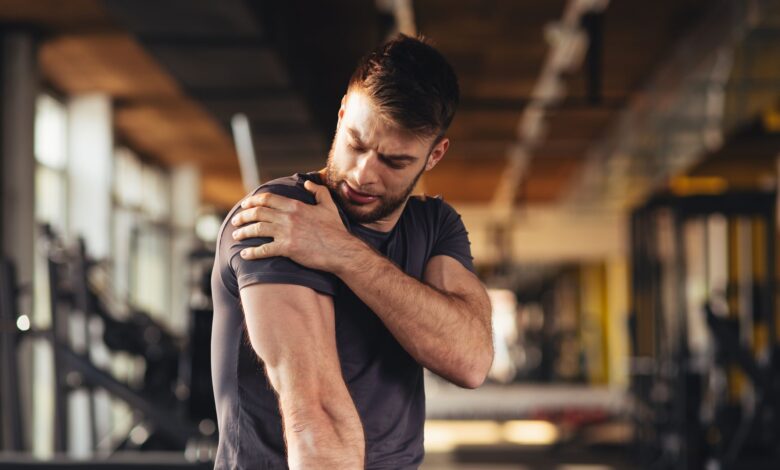How to Manage Sore Muscles and Joint Pain

You’ve worked hard all week, so when the weekend arrives, you want to play just as hard. Nothing beats a few rounds of golf, a hike in the mountains, or an intense workout at the gym to recharge your batteries.
However, all of that exercise can lead to soreness and stiffness a day or two later. Muscle pain should not be ignored. Learn about the causes and treatments so you can stay on track.
What’s Causing My Sore Muscles?
Sore muscles are normal after working out, playing sports, or even doing housework, especially if you:
- You did something unusual, such as running a marathon when you normally jog a few miles.
- You abruptly increased the intensity of your workout or the duration of your workout.
- You did exercises that stretched your muscles instead of shortening them. For example, you walked downhill or stretched your arm out when you did a bicep curl.
If you change your workout routine in these ways, you might hurt your muscle fibers and connective tissues in small ways. You’ll start to feel sore about a day later.
“That is referred to as “delayed onset” muscle soreness,” says Ethel Frese, PT, associate professor of physical therapy at St. Louis University. “It will peak in about 48 hours and then gradually improve.”
The good news is that if you repeat the same activity, your muscles will begin to adapt. “You will have no or less soreness because you have strengthened the muscle or connective tissue,” says Allan H. Goldfarb, PhD. He is an exercise physiologist and professor at the University of North Carolina, Greensboro.
What’s Causing My Joint Pain?
Osteoarthritis is typically characterized by sore and achy joints. As you get older, this inflammatory condition becomes more common. The cartilage that normally cushions the joints wears away, causing inflammation and pain.
Overuse or injury can also cause joint pain, such as tennis elbow or a knee injury caused by a ligament or meniscus problem. Ligaments are tissue bands that connect bones in your body. A meniscus is a rubbery disc in your knee that cushions it.
Treating Sore Muscles and Joint Pain
When it comes to nursing sore muscles, one of the most common questions is whether to use heat or ice. Experts say to use indirect ice, which is an ice pack wrapped in a thin towel, for quick pain relief.
“Heat will feel good while it’s on, but it’s not going to reduce or eliminate the damage any time soon,” Frese says.
To reduce inflammation, Goldfarb recommends icing the sore area immediately after the activity. Then, later, use heat to increase blood flow to the area. Heat can also help relieve joint pain.
If you experience muscle pain after a while, you can take Pain O Soma to help relieve the discomfort. Just be cautious when taking NSAIDs on a regular basis. According to Goldfarb, long-term use can impair your muscle’s ability to repair itself.
Consult your doctor or pharmacist about any interactions that these over-the-counter medications may have with other medications you are taking. Also, you may need to avoid some medications if you have ulcers, kidney disease, liver disease, or other conditions.
Sometimes more than an ice pack or over-the-counter pain reliever is required to soothe sore muscles. Muscle pain that is sudden and intense is a sign that you have injured yourself. If your pain is severe or lasts more than a few days, contact your doctor.
How Do I Prevent Sore Muscles and Joint Pain?
Stretching before a workout was once recommended by experts to avoid sore muscles. However, studies show that stretching ahead of time does little to prevent soreness or injury. According to Frese, it is best to warm up before exercising. Stretch after your muscles have warmed up.
A few natural substances, such as antioxidants like vitamin C, are promoted for preventing sore muscles. However, before taking high doses of any vitamin, consult your doctor. Serious exercisers who consume protein may find relief from post-workout soreness. Protein supplements were found to help sore muscles after intense exercise in a study of marines.
Ease up on exercise and consult your doctor about medication.
One of the best ways to keep from getting sore muscles is to slowly add exercise to your daily routine. There are numerous websites where you can purchase Pain O Soma. This medication is available for purchase on a variety of websites. However, only the Woodstock Family Medicine website provides high-quality, low-cost Pain O Soma medication.
“Begin with lighter exercise and gradually increase,” Frese advises.
If you have a health problem or are worried about your health, you should talk to your doctor before starting an exercise plan. They can help you find a way to exercise that is both safe and good for you.
When you have joint pain, it’s tempting to curl up in bed. Exercise, on the other hand, is one of the best things you can do for your joints. “Our joints need to move in order for us to get nutrition,” Frese says. Weight-bearing exercises can aid in the strengthening of the muscles that support the joint. Just make sure you’re not overworking yourself.
Working with a physical therapist can also be beneficial because they can show you how to exercise safely and maintain good posture to avoid injury or worsen joint pain.
Click hear: ventsabout





